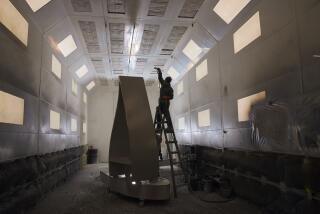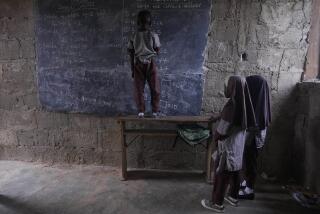Light for the Third World
- Share via
When the people of San Buenaventura in Guatemala tested their newly installed solar panels, the ceremony was marked with food, drinks and marimba music--fanfare one might expect at such a momentous event. Never before had electricity graced the small Guatemalan village of 60 households.
But what Ivan Azurdia remembers most about that night five years ago is the awe-struck look on the children’s faces when all the lights of the community were turned on.
“We adults can say speeches,” said Azurdia, manager of the Renewable Energy Project Support Office at Fundacion Solar, an organization that promotes renewable energy for rural communities in Central America. “But the face of the kids--it’s bringing light. You can’t describe that, really . . . how somebody who lives and grows up in darkness suddenly has light.”
With the exponential growth of the world’s population, the demand for power has quickly outpaced the ability of centralized, grid-based power systems to supply it. More than one-third of the 5.8 billion people in the world are left in the dark. Most live in rural areas so remote or impoverished that extending power lines to serve them would not be cost-effective.
Seeking to resolve this dilemma has led both private and government agencies to turn to small, decentralized renewable energy sources such as those provided by Azurdia’s agency.
Energy from the sun, wind, water and organic material as well as heat from the Earth’s interior often can be harnessed in villagers’ backyards, making proximity to a central power station unnecessary. This provides cleaner energy at a lower price.
“If you live in a house five kilometers off the grid, it’ll cost $5,000 to $10,000 a kilometer to run a power line out to you,” said John Kadyszewski, director of the Renewable Energy Team at Winrock International, a nonprofit economic development organization based in Arkansas.
“I can put a [solar] power system on that house for $500 to $600,” said Kadyszewski with the flair of a salesman. An $800 solar energy system can produce up to 50 watts of power per household, enough to power light bulbs and radios. A $1,200 wind turbine can generate one kilowatt, enough to power irrigation or cooling systems that a whole community can share.
“Many of these people are already spending $10 a month buying candles, kerosene, wood and charcoal for cooking,” Kadyszewski said.
Surveys conducted by Winrock in field offices indicate that people will opt for cleaner fuel sources, given the opportunity.
Renewable energy programs gained more national attention after President Clinton set the goal last year--just months before the global warming conference in Kyoto, Japan--of installing solar panels on a million U.S. rooftops by 2010. In addition, environmentally friendly energy is becoming a viable option for people in California because of deregulation of the power industry and a $540-million state subsidy for such “green power.”
But unlike in most areas of the United States, green power in rural, isolated areas of other countries doesn’t have to compete against established, coal-based power sources. Renewable energy programs in these areas have grown with financial and technical support from government agencies and private organizations. The U.S. Department of Energy estimates that renewable energy use in the developing world will grow 60% by 2015.
“Developing an international market is real important because the rural areas of developing nations represent a cost-effective niche for renewables,” said Dan Kirshner, senior economic analyst at the Environmental Defense Fund. “If we were starting over again with our [U.S.] rural areas, it’d be unlikely that we’d develop the current grid systems we have now.”
That’s not to say that the effort to hook up these developing communities is easy. Most people in rural areas of developing countries--some with annual incomes below $1,000--cannot afford the initial cost of the power systems without financial assistance. Much of the aid comes in the form of bank loans and credit plans that allow people--or communities, in the case of wind turbines--to pay for the systems over two to three years.
For those people and communities that make the investment, the new source of energy can bring about tremendous improvements in their quality of life. A seamstress in Brazil who took a week to make one blouse by hand can now make 15 blouses in the same period with a sewing machine. A farmer in Indonesia who spent up to 30 hours a week fetching water for his crops quadrupled his productivity with a water pump.
The renewable energy programs have also created new market opportunities for small businesses. Local stores are needed to sell spare parts and supplies for the new power systems.
“We’re not doing any good if these people must go into the city to buy light bulbs,” Azurdia said. In places like San Buenaventura where families now have bank accounts, the programs have encouraged financial planning.
“It’s not so much that we’re providing technology as we are promoting growth,” Kadyszewski said. “We’re trying to bring these people into the modern world, to get them to participate in the global economy.”
There are also potential benefits for the U.S. economy in promoting renewable energy abroad. The United States commands more than 40% of the market for all solar photovoltaic panels, and more than 70% of the panels are sold overseas.
“From wind and solar to biomass and fuel cells, the opportunities are extraordinary to sell technology and develop overall systems abroad,” said Dan W. Reicher, assistant secretary for the Energy Efficiency and Renewable Energy Network at the U.S. Department of Energy.
While bringing electricity to these communities may make good business sense, environmentalists believe the most important benefit of renewable energy programs is that they’re ecologically friendly.
“If all of China were to electrify and burn high-sulfur coal, it’d choke the planet,” said George Douglas, a spokesman for the U.S. National Renewable Energy Laboratory. “It makes sense for developed nations to share technology that makes electrification as clean as possible so they don’t repeat the same mistakes that we made.”
More to Read
Sign up for Essential California
The most important California stories and recommendations in your inbox every morning.
You may occasionally receive promotional content from the Los Angeles Times.













